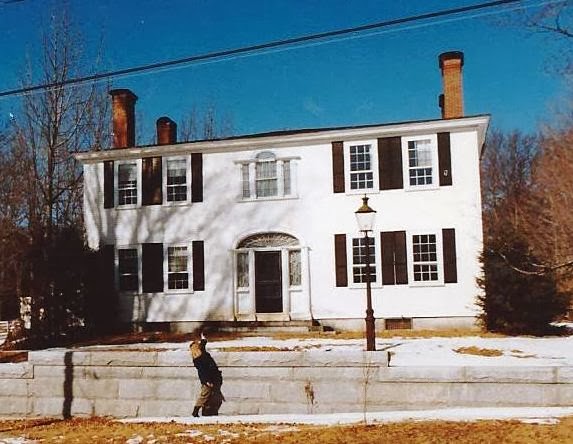THE BEST OF THE BEST
A number of years ago I accompanied friends to look at a house
in rural Maine. The village of North
Parsonsfield is way off the beaten path but rich in architecture for more than
one reason.
Arriving at the house we entered through the ell in the rear of
the house. I had no idea what we were
about to see.
 |
| The Blazo-Leavitt house, circa 1900 (Wikipedia) Similar view, circa 1990s |
From the kitchen area in the ell a door was opened into the front
hall. I gasped and almost had to hold
onto the door frame. I had never seen
such a beautiful hall! It was
spectacular with a sweeping hanging staircase.
Looking toward the front door was the most beautiful fanlight with a paneled and grain painted front door flanked by sidelights.
 |
| Old photo showing front hall and door |
Looking toward the front door was the most beautiful fanlight with a paneled and grain painted front door flanked by sidelights.
 |
| Side hall intersects with main hall |
The stairs themselves were grain painted and there was
fantastic decorative painting throughout the house.
One wall in the hall had a beautiful Federal period built-in with
drawers; maybe a chest of drawers or perhaps a secretary recessed into the
wall.
A side hall intersected the main hall. It led to another beautiful door topped by
another beautiful fanlight, also with sidelights.
Throughout the house we viewed beautiful fireplaces and
mantles. More decorative painting, and
lovely wallpapers further enhanced this spectacular house. The moldings and intricately carved
decoration took your breath away.
 |
| Grain painting on staircase |
Over the next few weeks I returned to accompany others who
were interested in purchasing the house but that was a long time ago.
The photos used in this post are mostly those I took sometime in the 1990s supplemented by others found on the Internet. Many are more flawed than I had hoped for after being stuck together for twenty years.
The photos used in this post are mostly those I took sometime in the 1990s supplemented by others found on the Internet. Many are more flawed than I had hoped for after being stuck together for twenty years.
A few days ago I was searching the Internet for a friend who
wants to find a country house in Maine.
There it was! Apparently the
house was recently on the market again but not for sale at this time. It is unoccupied.
 |
| Detail of finest molding on staircase (Internet photo) |
One of the front rooms in the house was particularly pleasing with beautiful wallpaper and enhanced by the best decorative grain painting on fireplace front and window seats as well as the beautiful grain painted doors.
 |
| Decorative panels above the window seat and below the mantle. |
I called my friend who had looked at it so many years ago as
a possible buyer. We got excited all
over again reminiscing about this fabulous house. She hit the Internet and much to our delight there was a lot to find, including a descendant of the original
family, a poet, who has published a memoir of the house available on Amazon for
about $6.00. (Two of them sold yesterday
as my friend and I both ordered a copy)
The house is well documented and is listed on the National Register of Historic Places as it well should be.
The housewright who built the house was Thomas Eaton who also built Wallingford Farm in Kennebunkport and other important buildings. The designs were from Asher Benjamin who published America's first pattern book, "The Country Builders' Assistant" in 1797 giving country architects unfamiliar with Boston, Salem or Newburyport the ability to create beautiful houses and churches far from the centers of influence at that time.
The house is well documented and is listed on the National Register of Historic Places as it well should be.
The housewright who built the house was Thomas Eaton who also built Wallingford Farm in Kennebunkport and other important buildings. The designs were from Asher Benjamin who published America's first pattern book, "The Country Builders' Assistant" in 1797 giving country architects unfamiliar with Boston, Salem or Newburyport the ability to create beautiful houses and churches far from the centers of influence at that time.
 |
| More grain painting on the doors in green room |
As I worked on this post and scanned my old photos I decided to take a look at the recent real estate photos online taken in September 2013.
Oh, no! Much to my horror, I am unable to find a trace of the fantastic decorative painted which adorned this house. The front staircase has clearly been painted.
How could anyone have the nerve to undo what was so beautiful and remained intact for 150 years! I am at a loss for words.
Whatever the case I will complete this post so all can appreciate what was.
Parlor when last descendants lived there (Internet photo)
 |
| Built-in drawers resemble a piece of fine Federal furniture |
 |
| Typical Federal mantle with fine molding that is not visible in the photo |
The photo below is a close-up of the molding to show
the incredible detail in this fine woodwork.
 |
| Detail of fine molding inn blue room |
 |
| The red room |
 |
| Pretty salmon walls |
passed down through numerous generations of the original family until 1973 when it was sold out of the family to others. During this more that 150 year span of time, antiques and family heirlooms had remained as each generation left its mark on the house and its contents.
Although it is not in the hands of the original family any longer the descendants have not forgotten this wonderful house where they spent carefree summers in the country. From the house they could see a distant mountain in New Hampshire, the foothills of the White Mountains.
 |
| Distant mountain is the view from the house |
In addition to spectacular Federal period houses another reason to admire Parsonsfield is the evidence of numerous hand painted wall murals in the style of Rufus Porter but actually painted
by his nephew, Jonathan Poor. There are
several houses with beautiful examples of his work. He often signed his work and dated it leaving
no doubt that he was the true artist and not Rufus Porter, the more familiar name. The
Blazo-Leavitt house does not have murals as far as I know but at least three
other houses are lavishly decorated. The
artist who did the decorative grained painting may be unknown.
 |
| Jumping for joy! |
If there are readers out there who know what is going on with this house, please leave me a comment.
Thanks for reading.
Pru
PS Here are some photos taken in Sept., 2913 from the Internet. It is difficult to identify the rooms. You can see that the graining is missing. It is now another huge house needing work.
 |
| Front room with no wallpaper or grain painting. Floors sanded with no patina left. Cushions added to window seats |
 |
| The staircase show no signs of decorative painting. The door at the rear of the hall appears enlarged., Black and white floor added |

























